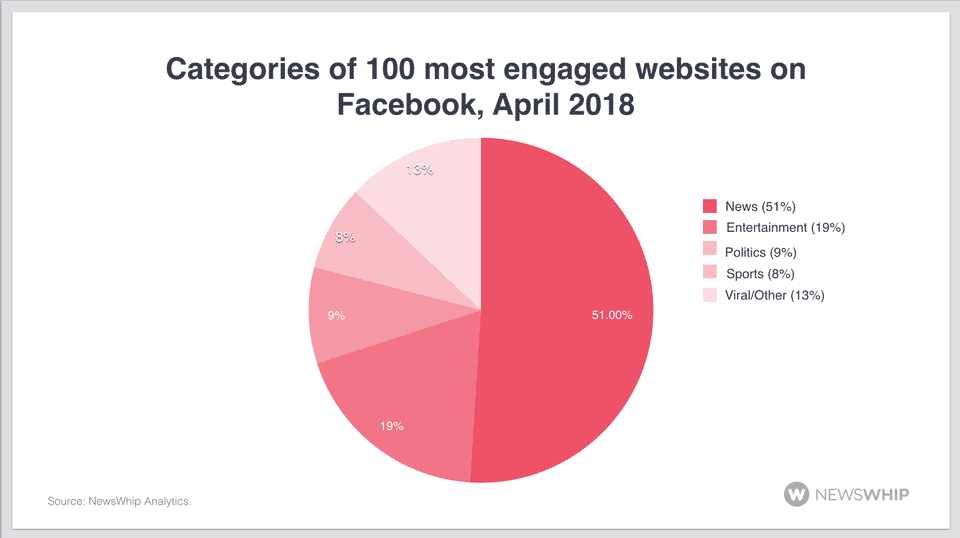We look at the data to see what types of websites saw the most engagement on Facebook in April 2018, and contrast that with the stories that tend to go viral on the platform.
In our recent analysis of the sites that are seeing the most attention on Facebook in April 2018, there were a few interesting points related to the composition of the sites that were seeing traction in the news feed.
More NewsWhip data may help shed some more light on the sites and stories that are seeing traction on Facebook in 2018.
Last month, the rankings showed the Fox News network regaining its position as the leading publisher on Facebook, with over 30 million interactions on its articles.
But after a significant engagement increase for most sites on the list in March, practically all of the top 25 sites saw decreases in engagement in April, while fake news stories were still seen to reach the tops of the most shared stories list, despite new measures from Facebook.
What kind of websites have large audiences on Facebook?
In this analysis, we take a closer look at the top 100 sites and stories on Facebook in April 2018, by categorising them based on subject matter and coverage.
As mentioned in the rankings last month, some of the most popular sites on Facebook are news-focussed, and this analysis bears that out.
Let’s take a closer look at the top 100 sites that made the most-engaged list in April, categorised based on total engagements with the web content that they published that month. Engagements with native content such as Live videos are not included in this analysis.

There’s a high number of news sites in the top 100, with the vast majority of those sites based in the US. Other countries including the UK, Philippines, India, and English language versions of Chinese and Russian news sites are also represented.
These news sites include a wide range of publishers, from regional news sites like the Chicago Tribune and the Manchester Evening News, to international news brands in broadcast and print, such as BBC News and the New York Times. Also included are digital native names like the Huffington Post and Politico.
Generally, these sites are publishing a lot of different content, from breaking news to sports coverage and opinion pieces. What generally ties them together, however, is a large focus on current affairs coverage.
There’s another category for ‘political’ sites. These are generally more controversial websites which have been given extreme scores by the Media Bias Fact Check site. All of these sites are US-based, and the majority are right-wing/conservative. Sites here include publishers like the Daily Wire and Western Journalism, both of which appeared highly in the April rankings.
In the ‘entertainment’ section, there’s a wide range of websites, the large established operations such as BuzzFeed and Vice, to smaller newcomers, and international celebrity news websites, particularly in Korea.
Not all of these sites could be described as being purely ‘viral’ in nature — that is, creating a large amount of content with the sole aim of reaching social media audiences. That has been separated out into another genre of publisher, which predominantly publish curiosity-gap style stories, and clickbait headlines, to achieve as much engagement as possible.
They typically publish much less frequently than the other categories of websites in the analysis, and often achieve very little engagement on other platforms like Pinterest, Twitter and LinkedIn each month. Examples of these sites include Viral Hatch and Providr.com.
Sports sites are also popular in the news feed, making up 8 of the top 100 sites last month. These sites range from well-known names such as ESPN and Bleacher Report, to more viral-oriented operators such as 12up.com. A small number of India-based cricket news sites are also present, presumably thanks to the enormous popularity of the sport in that country.
The final ‘other’ category is a mixed bag. In this category, there are a few websites that have been known to publish spurious or outright false information. They too aim to go for virality as a primary marker of success, but their means of getting there are more dangerous and problematic than the ‘Viral’ category of sites referenced above.
Popular subject material includes fear mongering on topics such as immigration and religion, as well as political point-scoring related to public figures. (For the full list of sites, and much more, be sure to check out NewsWhip Analytics.)
Viral stories: A mixed bag
As for the stories that see traction in news feeds, there’s some variation in what makes the top 100. Many of the stories published in April that make the most engaged list were breaking news-related, and came from a range of mainstream news publishers including the New York Times and NPR.
However, it’s fair to say that there’s a lot of low-quality content in this list. One of the most striking differences between the most shared stories list and the top 100 sites list lies in the number of viral clickbait (and occasionally, outright fake) stories which achieve hundreds of thousands of engagements every month.
Their presence highlights one of the fundamental difficulties with social publishing algorithms — the multiplication effect of sensationalism. Although they make up a small portion of the overall volume of all stories shared on social media, their ability to achieve enormous engagement scores very quickly means that they can dominate discussion about publishing on the platform.
There’s no doubt that there is still a lot of engagement for different publishers on Facebook. But there are also questions remaining about how exactly Facebook’s proposed algorithm changes, announced at the start of the year, will impact news and publishing generally on the platform.
As Matthew Ingram wrote in his report of our rankings on the Columbia Journalism Review:
Does this mean Facebook’s algorithm changes aren’t having the desired effect? Not necessarily. With any ecosystem as gigantic as Facebook’s, changes from one month to the next could be caused by any number of things. Or it could be that enough people said they trusted Fox News and the Daily Mail in Facebook’s surveys, and therefore those sources are getting ranked higher.
Further analysis of social data can help shed more light on what goes viral on social media, and why.
To get full access to this data, and much more, sign up for a demo of NewsWhip Analytics today.











